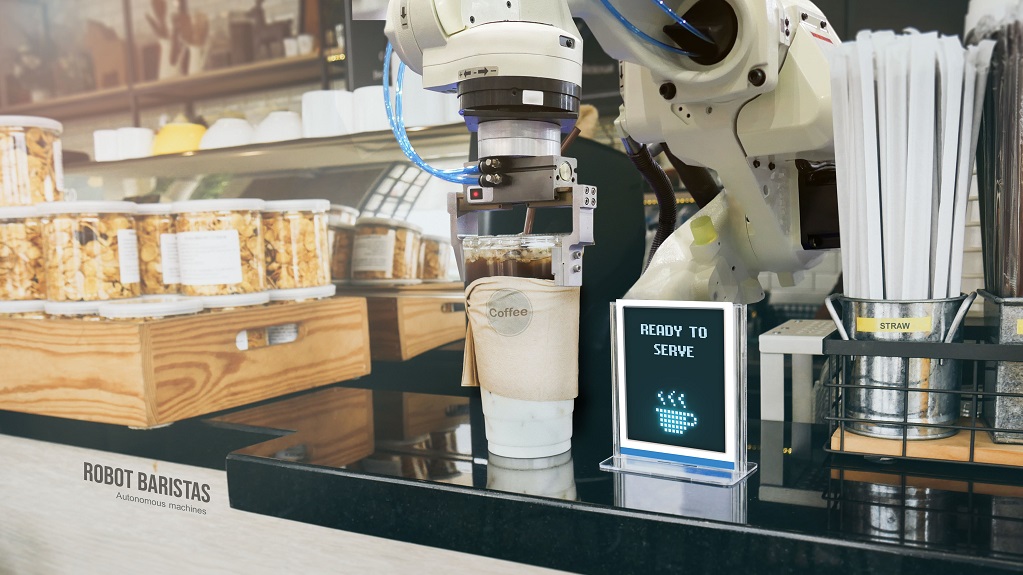3 Innovative Ways Restaurants Responded to the Pandemic That are Here to Stay
To say the pandemic/post-pandemic world brought about change is an understatement. As we approach 2022, almost all industries are regrouping and redefining what future daily practice will look like. Many changes that were born of necessity during COVID are now becoming the new norm.
The food and beverage industry is no exception; it has been at the forefront of shifting and adjusting practices and, by embracing advanced technologies and creative business practices, has been successful in transitioning and maintaining standards.
But which of these systems implemented as a means of survival — QR codes, robotics and creative delivery services — are part of the industry's future? Let’s take a closer look.

1. QR codes
What they are
Even pre-pandemic when they were used on a more limited basis, QR codes offer a contactless method of viewing menus, ordering and paying for services, as well as a way for customers to provide quick feedback.
Why they work
This technology allowed restaurants to adhere to strict COVID guidelines. It provided a mechanism for contactless customer service but had the added benefit of decreasing the cost incurred with printing single-use disposable menus. No surprise: This unexpected cost-savings was embraced across the industry.
Why they don’t
The use of these QR codes, however, is not without its issue. Even today, some of the older generations have not embraced this use of technology.
Prediction
As we look to the immediate future, restaurants will still need to provide a safe, sanitary way to serve these consumers. Disposable, paper menus will need to be an interim solution to maintain a positive customer experience. As we look to the long-term future and we see the shift in our consumer demographics, it makes sense that acceptance of this technology will grow and eventually the need for paper menus will become obsolete.
Read More >>> Has the Pandemic Changed Restaurants for the Better?

2. Robotics
What it is
One unforeseen carryover as we come out of the pandemic is the lack of human labor. Trying to keep a business such as a restaurant open with less staff and strict COVID guidelines is challenging enough but maintaining high-quality standards with these issues can be a daunting task. Robotics seems to be the answer.
Why it works
As we moved to 2021 and beyond, the increased staffing shortages felt across all businesses drove a surge in the interest in using robotic technology to help solve some of these problems. Companies are searching out opportunities to utilize robotic technology to assist with these day-to-day operations.
One fun example of this is MISO ROBOTICS, a company out of Pasadena, California. They are bringing “Flippy” the burger-flipping arm to the mainstream. The creation of a robotic arm to repeatedly do a task and complete it consistently solves problems of quality and staffing. Flippy is being modified for use in several other tasks, filling positions that are highly understaffed. They have claimed, “The definition of the Kitchen of the Future is changing given all of the renewed public health and safety concerns, and we believe we are at the forefront of this trend.”
Why it doesn’t
Technology takes time to test and develop — and acceptance at the customer level must evolve too.
Prediction
When it comes to the use of robotics, the pre-pandemic Hospitality industry sat merely on the edge of the possible uses for these advanced technologies. Although interest and use was growing, and the industry seemed to embrace this technology, growth in this area was slow in its mainstream acceptance and use. The pandemic has driven the need for faster development and widespread industry applications.

3. Creative Delivery Services
What it is
Very quickly into the pandemic, the food and beverage industry discovered that people still wanted to eat “out” but had no way to access the restaurant. Basically, the restaurant had two options: take on the task in-house and figure out how to get their own employees to make deliveries or they could use third- party delivery services such as DoorDash or Uber Eats.
Why it works
Both solutions come with benefits and drawbacks: The use of in-house delivery would require planning and time to start the service along with increased costs; however, the advantage would be an opportunity to keep staff employed when possible. The other option of using a third-party delivery company could be quicker to implement but it would also require set-up time and learning the communication system between the restaurant and the delivery driver.
Why it doesn’t
What you gain in efficiency with third-party systems, you must balance with their challenges, Point of Service (POS) system integration being one such issue. Many delivery companies will supply the restaurant with an iPad running their app where orders come in. Staff must then check these and enter orders into their POS system.
The other issue is cost. Most delivery companies will take up to 20% per order as their fee. One last concern with these third-party companies is sharing data. For example, when a consumer places an order through DoorDash, data such as consumer profile, ordering history and trends are captured; however, this information is not shared with the restaurant.
Prediction
Regardless of the method of delivery implemented, increased business from online ordering will continue to challenge restaurants as they balance in-house business with an increase of online deliveries. Whether they manage this service themselves and face the need for added delivery personnel, insurance costs, and automated ordering and payment or they use a third party and give up quality control as their food leaves their establishment there is much to consider. No one solution will fit every food establishment.
What's Next for Restaurants
In conclusion, the food and beverage industry was and continues to be one of the most highly impacted industries during this pandemic. This industry was hit hard with obstacles but adjusted quickly to these ever-changing challenges. Embracing technology and changing business practices lead to increased efficiency and in some cases cost savings.
As we look to 2022, it is safe to say that many of these changes will remain. Modifications will certainly, and should certainly, occur so that service efficiencies and quality standards are supported. It is important to always remember that it is not just the industry that is different, the consumers of today are different; and the industry will need to continue to grow and evolve to support these ever-changing differences and expectations.



